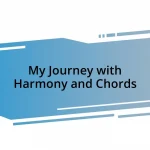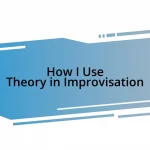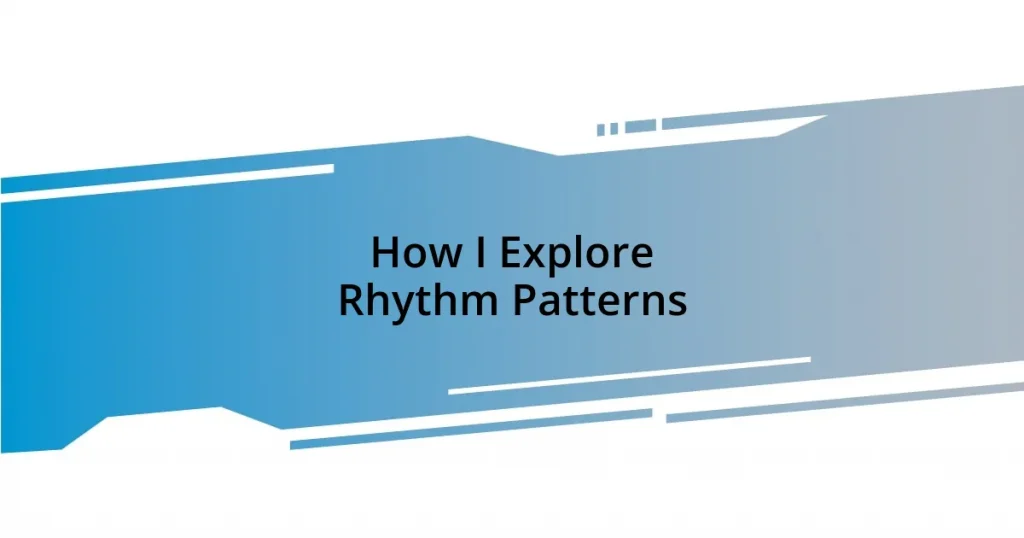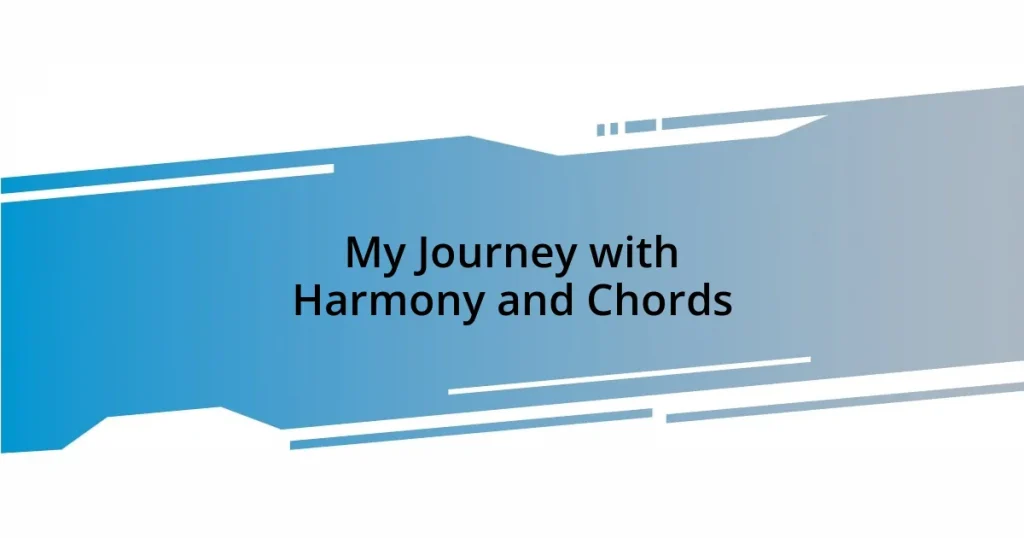Key takeaways:
- Rhythm is fundamental to music, involving the placement of sounds in time, which can evoke various emotions.
- Identifying different rhythm patterns, such as 4/4, 3/4, syncopation, and polyrhythms, enhances musical appreciation and creativity.
- Using a metronome effectively aids in mastering rhythm patterns and improves timing and precision in practice.
- Incorporating rhythmic variations, such as dynamics and tempo changes, can transform musical expression and engage listeners more deeply.
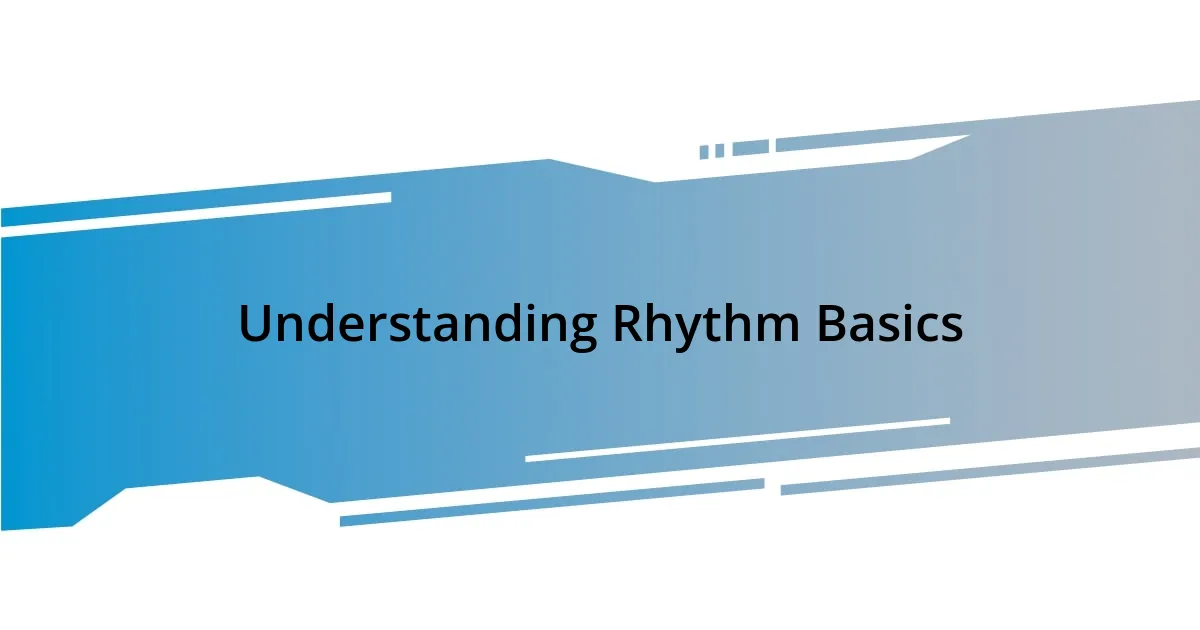
Understanding Rhythm Basics
When I first delved into rhythm, I was surprised by its simplicity yet profound complexity. At its core, rhythm is the placement of sounds in time, a canvas where musical ideas come to life. Have you ever tapped your foot to a song without even thinking about it? That instinctive movement is our body’s way of participating in the rhythm, illustrating how fundamental it is to our musical experience.
Understanding the basic elements of rhythm is essential to any musician or budding enthusiast. You have beats, which are the basic units of time, and then there’s the concept of meter—essentially how we group those beats together. When I was learning, I found that counting rhythms out loud helped me internalize patterns far better than merely listening. It’s like having a conversation with the music; the more you practice, the more fluent you become in its language.
Patterns in rhythm can evoke distinct emotions; for instance, a steady, driving beat can energize you, while syncopation might create tension or surprise. I vividly remember the first time I heard a complex polyrhythm. It felt like my heart was racing with excitement, as if discovering a hidden treasure. Doesn’t that resonate with you? Rhythm isn’t just a backdrop in music; it’s a vibrant pulse that connects us to our emotional landscape.
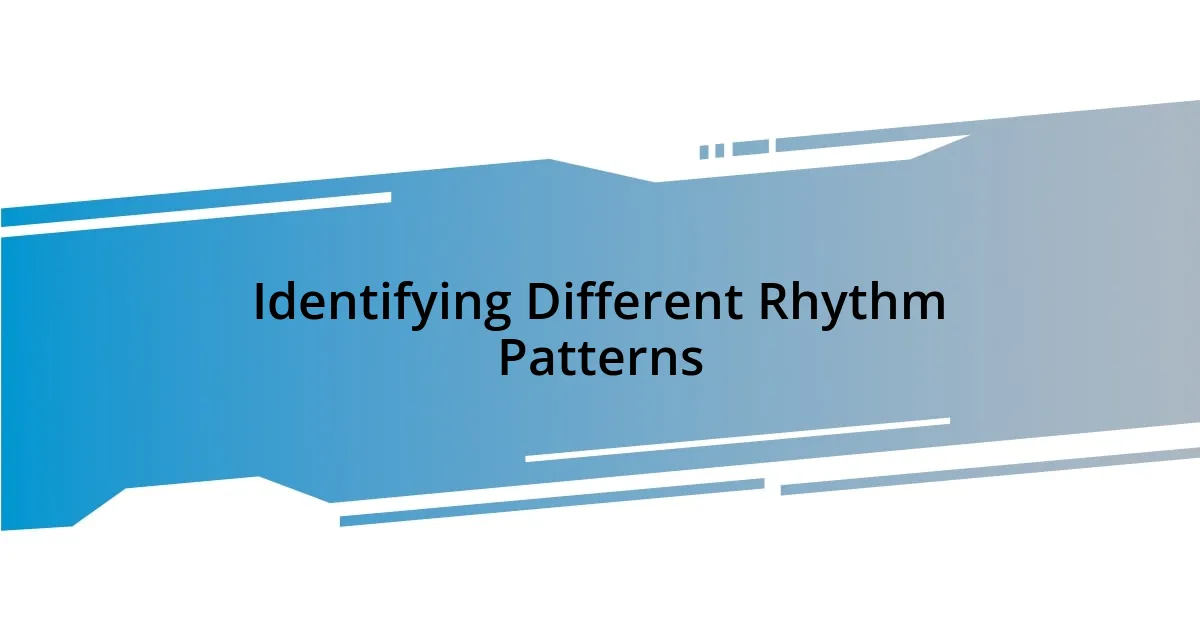
Identifying Different Rhythm Patterns
Identifying different rhythm patterns can be a fascinating journey. When I started exploring this subject, I found it helpful to listen closely to various styles of music, from jazz to classical. For example, jazz often uses syncopation, where the emphasis shifts from the expected beats, creating a sense of surprise. Have you ever noticed how that unexpected hit in a song can make you want to stand up and dance? It’s that discovery of distinct patterns that adds layers to our musical appreciation.
Another technique I discovered is to visualize rhythms using clapping or tapping, which helps me categorize them more easily. For instance, I remember jamming with friends and differentiating between 4/4 and 3/4 time signatures. It was enlightening to see how the same melody could feel entirely different depending on its rhythmic framework. This hands-on approach not only deepened my understanding but also made learning enjoyable.
One of the most striking patterns I encountered was in traditional African music, where polyrhythms intertwine multiple rhythms simultaneously. It reminded me of weaving a rich tapestry of sound and emotion. The anticipation that builds when identifying these layers really fuels my passion for rhythm. It makes you appreciate the intricate way rhythms can tell stories within a song.
| Rhythm Pattern | Description |
|---|---|
| 4/4 | Common in pop and rock; four beats per measure, creating a steady pulse. |
| 3/4 | Found in waltzes; three beats per measure, often creating a lilting feeling. |
| Syncopation | Emphasis on off-beats, creating surprise and unexpected accents. |
| Polyrhythm | Multiple contrasting rhythms played together, creating complex layers. |

Using a Metronome Effectively
Using a Metronome Effectively
A metronome is a musician’s trusty ally, and I’ve found that using it can be a game-changer for mastering rhythm patterns. When I first picked one up, I was amazed at how a simple ticking sound could help me maintain a steady tempo. I remember practicing scales at different speeds while tapping my foot in sync, feeling the rhythm lock into place. It felt like unraveling a secret code—each click guiding me closer to precision and confidence.
Here are some effective ways I’ve learned to utilize a metronome in my practice sessions:
– Start Slow: Begin with a slower tempo to ensure accuracy before gradually increasing the speed.
– Vary Your Subdivisions: Experiment with different note values, like quarter notes or eighth notes, to diversify your rhythm practice.
– Accent the Beat: Use the metronome’s accents feature—I found it invaluable when trying to emphasize certain beats in a measure.
– Combine Techniques: Pair metronome practice with clapping or tapping to reinforce timing physically—it’s a fun way to engage both mind and body.
– Set Goals: Challenge yourself by setting tempo targets; it adds a sense of accomplishment each time you reach a new speed.
Embracing the metronome transformed my self-discipline. At first, it felt a bit mechanical, but soon, I discovered how it fostered my creativity. I could explore complex rhythms knowing I had that steady beat underneath. Just like riding a bike, once you find your balance, the possibilities really open up. You might be surprised by how this simple tool can elevate your rhythm game!

Exploring Syncopation Techniques
Exploring syncopation has truly been a game changer in my musical journey. I remember the first time I played a syncopated rhythm on the piano; it felt like discovering a hidden door in a familiar room. The way the off-beats made the melody leap and dance—it was exhilarating! Have you ever felt that rush when a rhythm just clicks? That feeling is what makes syncopation so captivating.
One technique I’ve found helpful is practicing syncopation in small phrases. By breaking down a complex syncopated rhythm into manageable chunks, I can really grasp how the accents fall on those unexpected beats. I recall a rehearsal where we struggled with a tricky jazz piece, but once I isolated the syncopated section and practiced it slowly, the entire song transformed. Suddenly, what felt chaotic became this vibrant and lively piece of music, full of energy. It’s amazing how this method not only improved my timing but also helped me to appreciate the dynamic free-flow that syncopation brings.
Another technique that often sparks my creativity is layering syncopated rhythms. I like to play a steady beat on the drums while incorporating syncopated melodies on top, creating a rich texture. This not only enhances my understanding of rhythm but brings a real joy to the practice room. It reminds me of a conversation where each person brings their own thoughts and ideas—together, they create something truly special. Have you tried layering rhythms? It might just open up a whole new world of musical exploration!
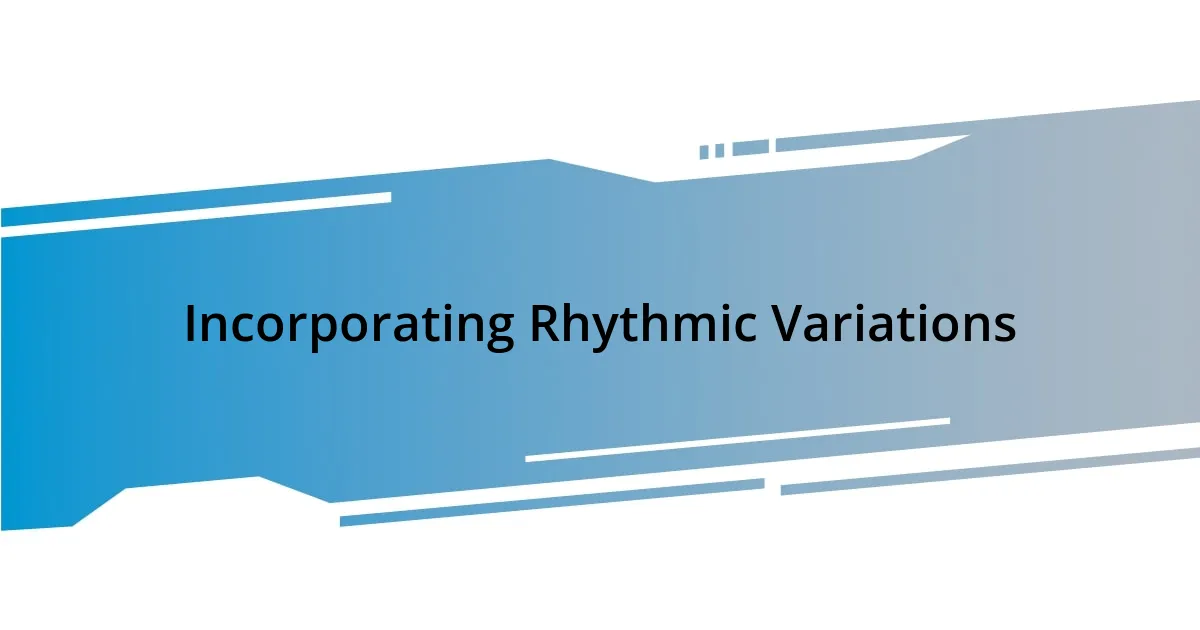
Incorporating Rhythmic Variations
Incorporating rhythmic variations into practice sessions has significantly transformed my approach to music. One of my favorite techniques is to experiment with contrasting dynamics. For instance, I’ll start a phrase softly, then dramatically switch to a loud accent. It’s like a dialogue between two characters—each variation brings out different emotional flavors. Have you ever noticed how dynamics can shift the mood of a piece? I find that playing with these contrasts makes the music more expressive and engaging.
Another empowering way I incorporate rhythmic variations is through improvisation. I often set a base rhythm and let my imagination run wild over it. I’ll throw in unexpected pauses or syncopated elements that keep me on my toes. I remember one jam session where I took risks with my rhythm and it sparked a spontaneous groove among my bandmates. The joy of creating something fresh in the moment is unmatched—it’s like we were all connected, riding the wave of inspiration together. Have you had moments in your music where the rhythm just takes over? Those are the moments we live for!
Lastly, I’ve found that shifting the tempo within a piece can create a thrilling contrast. I love to move between slow, contemplative sections and quick, energetic rhythms. It allows me to explore a range of emotions, transforming a straightforward piece into an emotional journey. There’s something exhilarating about the way audiences react to those unexpected shifts, often leaning in with anticipation. Have you tried altering tempos in your own playing? It invites listeners to engage with the music on a deeper level, making the experience all the more memorable.
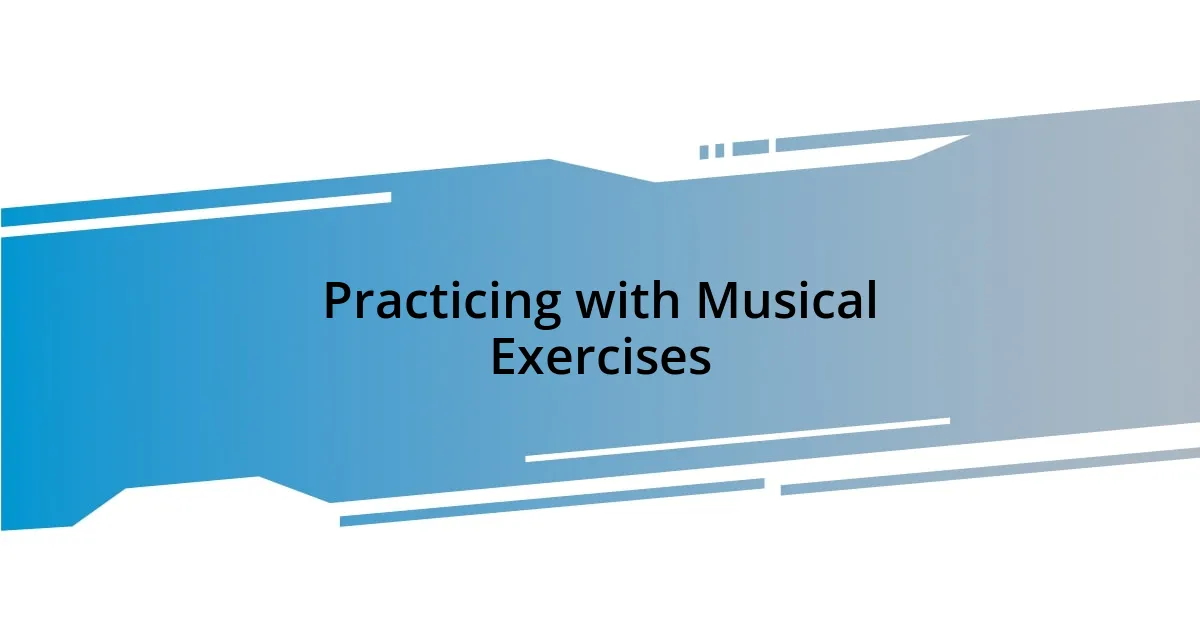
Practicing with Musical Exercises
Practicing with musical exercises can be a rewarding experience, especially when I approach them with intention. One exercise that stands out is clapping out rhythms before playing them on my instrument. It’s fascinating how this simple practice strengthens my internal metronome. I remember a time when my band was preparing for a performance, and I struggled to keep the tempo steady. Clapping out those tricky measures transformed my timing—it was like unlocking a secret vault of rhythm!
When I dive into rhythmic exercises, I often turn to drumming patterns to enhance my coordination. I’ll spend time practicing a basic pattern on the drums while playing a contrasting melody on the piano. I can still recall a session where I mixed a simple bass drum beat with syncopated chords; the rush of those layers coming together was intoxicating. Have you ever felt that thrill of discovering a new rhythm that just clicks? It’s in those moments that I feel the true heartbeat of the music!
A technique I swear by is recording my practice sessions. Listening back allows me to identify rhythmic inconsistencies that I might miss in the moment. I find this critique invaluable; it’s like having a trusted mentor guiding my growth. There was a time when I heard a timing issue that I thought I had mastered—I was baffled! Addressing it opened up a new level of understanding for me. Have you ever listened to your own recordings and discovered something new? It’s a humbling yet enlightening experience that can elevate your musical journey significantly.
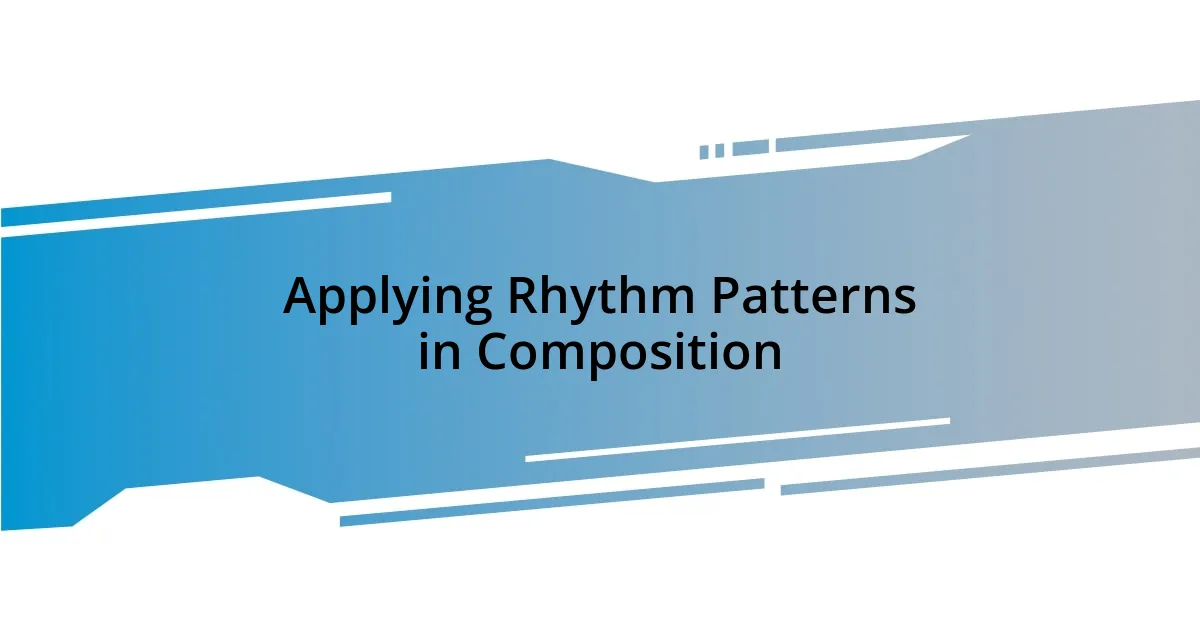
Applying Rhythm Patterns in Composition
Applying rhythmic patterns in composition can truly redefine how you craft your musical pieces. I often find myself layering different rhythms to establish a unique feel. For example, in one of my recent compositions, I decided to juxtapose a steady 4/4 beat with an off-kilter 5/4 section. That contrast created a sense of tension that pulled listeners in—didn’t it feel like they were on the edge of their seats? I still get excited thinking about how those rhythmic shifts shaped the entire narrative of the piece.
Another technique I love is to use rhythm patterns as a backbone for melody development. When I was working on a project about a year ago, I experimented with a syncopated rhythm that allowed my melodic lines to breathe and feel more expressive. I recall how delighted I was when an idea I initially dismissed turned into one of my best themes! The surprise of flowing melodies over a solid rhythmic foundation was a revelation—have you ever played around with rhythms only to discover a melody that sings?
Furthermore, the way rhythmic patterns can inform the structure of a piece fascinates me. I frequently utilize them to create sections within my compositions, almost like building blocks. During a songwriting session, I played a bouncy rhythm in the verses and shifted to a more subdued pattern in the chorus. That contrast didn’t just add texture; it told an emotional story, drawing the listener deeper into the experience. Have you considered how the rhythm shapes the emotional arcs in your compositions? It’s a powerful tool that can elevate your music to new heights.


